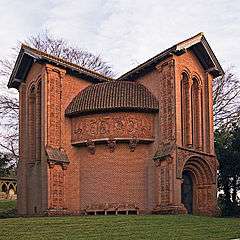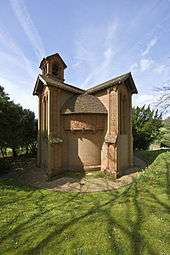Mary Fraser Tytler
| Mary Seton Watts | |
|---|---|
-1887-large.jpg) Mary Fraser Tytler painted by G.F. Watts | |
| Born |
Mary Seton Fraser Tytler 1849 India |
| Died |
1938 (aged 88–89) |
| Nationality | Scottish |
| Education | Slade and South Kensington School of Art |
| Known for | Painting, Ceramics |
| Movement |
Gothic Revival Art Nouveau |
Mary Seton Fraser Tytler (married name Mary Seton Watts) (1849–1938) was a symbolist craftswoman, designer and social reformer.
Biography
Born in India, she was the daughter of Charles Edward Fraser Tytler of Balnain and Aldourie, but spent much of her youth in Scotland and settled in England in the 1860s.
Trained at the Slade and South Kensington School of Art,[1] she initially became known as a portrait painter, and was associated with Julia Margaret Cameron and the Freshwater community. There she met painter George Frederic Watts and at the age of 36 (he was 69), became his second wife on 20 November 1886 in Epsom, Surrey.
After her marriage, she largely worked in the fields of Celtic and Art Nouveau bas-reliefs, pottery, metalwork and textiles. She co-founded the Compton Potters' Arts Guild and the Arts & Crafts Guild in Compton, Surrey. She designed, built and maintained the Watts Mortuary Chapel in Compton (1895); and had built and maintained the Watts Gallery (1903–04) for the preservation of her husband's work.
Tytler worked to create employment for impoverished people through the preservation of rural handicrafts, as well as trained workers in clay modelling for the Compton Potters' Guild and the work executed on the Watts Mortuary Chapel. She was a firm believer in the idea that anyone given the opportunity could produce things of beauty and that everyone should have a craft within which they could express themselves creatively. She supported the revival of the Celtic style, the indigenous artistic expression of Scotland and Ireland. In 1899, she was asked to design rugs in this style for the carpet company Alexander Morton & Co of Darvel, Liberty's main producer of furnishing fabrics. In cooperation with the Congested Districts Board, Morton had established a workshop in Donegal, Ireland, to employ local women, who had very little opportunity of earning a livelihood.
Tytler pioneered Liberty's Celtic style, with much of the imagery for the Celtic Revival carpets, book-bindings, metalwork and textiles for Liberty & Co. being based on her earlier designs at the Watts Mortuary Chapel.
Tytler was President of the Godalming and District National Union of Women's Suffrage Society[2] and she convened at least one women's suffrage meeting in Compton, Surrey.[3]
Watts Mortuary Chapel
 Watts Mortuary Chapel
Watts Mortuary Chapel Chapel, showing in foreground terracotta grave marker made in the Compton pottery
Chapel, showing in foreground terracotta grave marker made in the Compton pottery The door
The door Ceiling apex
Ceiling apex Embrasure & "altar"
Embrasure & "altar" Tree of Life & Seraphs
Tree of Life & Seraphs Showing campanile
Showing campanile
See also
References
- Barbara Coffey Bryant, "Watts, George Frederic (1817–1904)", Oxford Dictionary of National Biography, Oxford University Press, Sept 2004; online edn, May 2006 accessed 30 Dec 2006
- Franklin Gould, Veronica Mary Seton Watts - Unsung Heroine of the Art Nouveau (1998) ISBN 978-0-9515811-2-4
Notes
- ↑ "Compton Potter's Arts Guild". meridiangallery.co.uk. Retrieved 2008-12-19.
- ↑ See Craddock’s Godalming Directory, 1910, p.33, at Godalming Museum Library.
- ↑ See V. Irene Cockroft, New Dawn Women: Women in the Arts & Crafts and Suffrage Movements at the Dawn of the 20th Century (Surrey: Watts Gallery, 2005), p.13.
External links
 Media related to Mary Fraser Tytler at Wikimedia Commons
Media related to Mary Fraser Tytler at Wikimedia Commons- Watts Chapel
- Wolfsonian